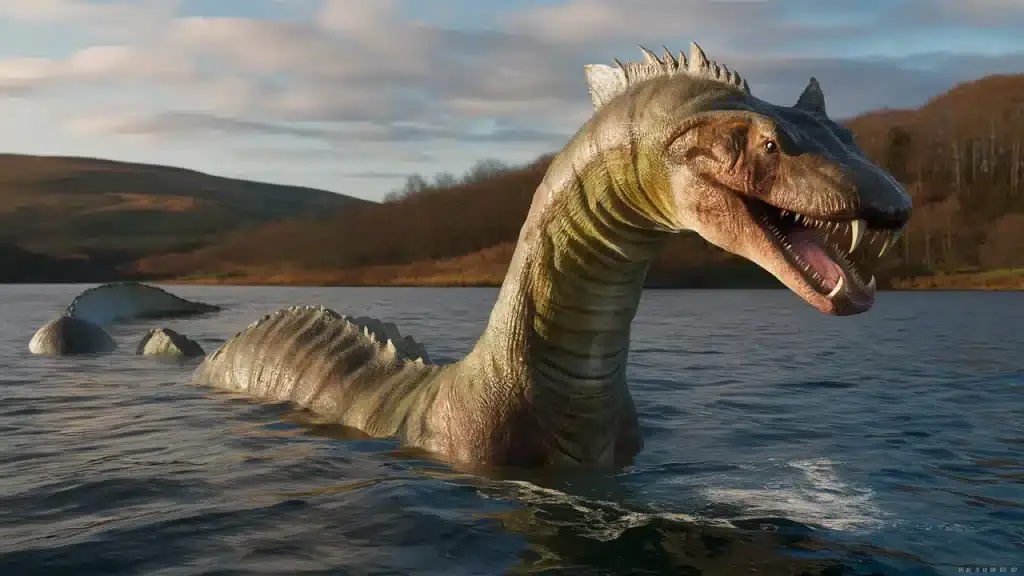The Loch Ness Monster has been a topic of fascination and debate for decades.
Nestled in the scenic Scottish Highlands, Loch Ness is said to be the home of this elusive creature.
For centuries, people have been captivated by the myths and legends surrounding Nessie, fueling endless speculation and intrigue.

Reports of the Loch Ness Monster date back to ancient times, with local stone carvings by the Pict depicting a mysterious beast with flippers.
Modern interest surged in 1933 when a new road provided clear views of the loch.
Sightings like the one by Aldie Mackay, who saw something black and wet in the water, have kept the legend alive.
Is the Loch Ness Monster real or just a myth? While much alleged evidence has been discredited, the story of Nessie continues to enchant locals and tourists alike. Check out more about this fascinating legend and what the evidence says about the truth behind the tales.
Historical Accounts of Nessie
The Loch Ness Monster, affectionately known as Nessie, has a rich history filled with intriguing sightings and dramatic tales.
These accounts date back to ancient times and involve key figures like St. Columba and the Picts.
First Sightings
Reports of Nessie date back to the time of the Picts, a group of people living in Scotland during ancient times.
The Pictish stones, crafted around the 6th and 7th centuries, often depicted strange aquatic creatures with flippers and long necks. These carvings are among the earliest visual representations of a creature that resembles Nessie.
In April 1933, a modern wave of sightings started when a couple reported seeing a large, rolling animal in the waters of Loch Ness.
This sighting caught the media’s attention, leading to numerous other reports. The descriptions usually refer to a creature with a long neck and multiple humps.
Eyewitness accounts have varied, with some describing Nessie as snake-like and others saying it’s more like a prehistoric plesiosaur. Despite the differences, the common thread is the belief in a mysterious creature lurking in the depths of Loch Ness.
St. Columba’s Encounter
One of the most famous historical accounts of Nessie involves St. Columba, an Irish monk credited with bringing Christianity to Scotland.
According to a 7th-century biography, St. Columba encountered a beast in the River Ness in 565 AD.
The story goes that a man was swimming in the river when he was attacked by a large creature.
St. Columba, witnessing the event, made the sign of the cross and commanded the beast to retreat. Miraculously, the creature obeyed and disappeared into the depths.
This account is significant because it links Nessie to early Christian missionaries and provides one of the earliest written records of a beast in the Ness area. Whether this story is factual or embellished, it remains a cornerstone in the legend of Nessie.
The Surgeon’s Photograph and Its Impact
In 1934, an image known as “The Surgeon’s Photograph” became the quintessential symbol of the Loch Ness Monster. This image stirred imaginations worldwide and had a lasting impact on the legend of Nessie.
The Daily Mail’s Role
On April 21, 1934, the British newspaper The Daily Mail published the famous photo, showcasing what appeared to be a creature with a long neck and a small head rising from the water.
This image fueled the Loch Ness Monster legend, captivating the public’s imagination and leading to a surge in reported sightings.
By sharing this photo, The Daily Mail played a significant role in making the Loch Ness Monster a global phenomenon. The photo was widely circulated, leaving an indelible mark on popular culture and cementing the narrative of a mysterious creature lurking in Loch Ness.
Robert Kenneth Wilson
The photograph was reportedly taken by Robert Kenneth Wilson, a respected English physician. Wilson’s reputation as a doctor gave the image an air of credibility.
He claimed to have snapped the picture while driving along Loch Ness. Wilson’s association with the photo lent it an authenticity that helped it gain widespread acceptance.
For many years, people believed Wilson’s photograph was genuine. The involvement of a medical professional added weight to the monster myth, making it even more compelling to the public.
Subsequent Analysis
In the years following its publication, the photo came under intense scrutiny. Researchers and skeptics began to question its authenticity.
It was eventually revealed that the picture was a hoax, created using a toy submarine with a model head and neck attached.
Christian Spurling, stepson of one of Wilson’s associates, confessed to fabricating the image.
Despite being discredited, the photo remains one of the most iconic and enduring images associated with the Loch Ness Monster. Even as a known hoax, it continues to attract interest and curiosity, demonstrating the powerful allure of the Loch Ness legend.
Scientific Investigations and Theories

The Loch Ness Monster has drawn the curiosity of scientists and enthusiasts alike. Scientific efforts to discover the truth include various large-scale operations and surveys.
Operation Deepscan
In 1987, a massive effort known as Operation Deepscan was launched to investigate the depths of Loch Ness.
It involved 24 boats equipped with high-tech sonar sweeping the loch.
The goal was to locate any large, mysterious creatures lurking beneath the surface.
The operation identified a few large, unexplained objects, but none could be definitively linked to Nessie.
This initiative helped highlight the difficulties of searching for a creature in such a vast and deep body of water.
DNA Surveys
In recent times, scientists have turned to DNA surveys to uncover the truth about Loch Ness.
Researchers from the University of Otago in New Zealand conducted a DNA survey of the loch’s waters in 2018.
By analyzing millions of DNA sequences, they aimed to catalog all creatures living in the lake.
Results showed no evidence of a Plesiosaur or other large unknown animals, but they did uncover a significant amount of eel DNA. This raised the possibility that sightings might actually be of oversized eels.
Sonar Readings
Over the years, numerous sonar readings have attempted to capture images of the Loch Ness Monster.
These investigations have at times produced intriguing results.
For example, during the Loch Ness Phenomena Investigation Bureau project in the 1970s, sonar detected large moving objects deep in the loch.
Modern sonar technology continues to be a vital tool. Though findings are often inconclusive, occasional blips and shapes keep the mystery alive and spur ongoing interest.
Cultural Impact and Popularization

The Loch Ness Monster has fascinated people worldwide, influencing media and drawing countless tourists to Scotland’s Highlands.
Media and Literature
The legend of the Loch Ness Monster captured public imagination especially after newspaper reports in 1933.
Publications such as the Inverness Courier played a big role in spreading stories of “Nessie,” leading to a media phenomenon.
Books, movies, and TV shows have depicted Nessie in various lights, from a fearsome dragon to a gentle giant.
Movies like Loch Ness Terror and Disney’s The Ballad of Nessie have further cemented Nessie’s place in pop culture.
Documentaries and news reports from PBS NOVA to London newspapers have kept the mystery alive for decades.
This blend of folklore and modern storytelling keeps the Loch Ness legend deeply ingrained in global consciousness.
Tourism in Loch Ness
The allure of seeing the Loch Ness Monster brings thousands of tourists to the scenic Loch Ness region each year.
Inverness, the gateway to the Scottish Highlands, benefits greatly from this influx.
Local businesses thrive on the steady stream of Nessie hunters eager to catch a glimpse or snap a photo of the elusive creature.
Tour operators offer boat tours and guided expeditions, promising a closer look at the lake’s mysterious waters.
The economic impact on Inverness and surrounding areas is significant, driving local economies and fostering a unique niche in tourism centered around this enduring legend.
Skeptics and Debunking The Myths

Skeptics have long challenged the existence of the Loch Ness Monster, offering natural explanations and debunking various photographs.
Natural Explanations
Many skeptics argue that the supposed sightings of the Loch Ness Monster can be attributed to natural phenomena.
For example, waves caused by boats or schools of fish can create illusions on the water’s surface.
Sometimes, logs or other debris floating in the loch might be mistaken for a creature.
Waves and weather conditions can also play tricks on the human eye, making ordinary objects look like something extraordinary.
Additionally, some have suggested that large fish, such as sturgeon, might be behind these sightings.
These fish can grow quite large and have a prehistoric appearance, leading to mistaken identities. This blend of natural occurrences and human psychology often results in the myths surrounding Nessie.
Debunked Photographs
Over the years, several photographs claiming to show the Loch Ness Monster have been discredited.
One of the most famous photos, known as the “Surgeon’s Photograph,” was later revealed to be a hoax.
This image, taken in 1934, appeared to show a creature with a long neck rising from the water, but it was actually a model.
Other photos and videos have similarly been debunked. Shadows, reflections, and even deliberate fakes have all contributed to the confusion.
Modern technology, including detailed analysis and enhanced imaging, has helped skeptics disprove many of these claims.
Loch Ness Beyond the Monster

Loch Ness in Scotland is more than just the home of the Loch Ness Monster. This large freshwater lake and its surroundings have rich ecological systems and notable features that make it a fascinating place to explore.
Ecology of Loch Ness
The waters of Loch Ness are deep and murky, giving it a mysterious charm. It’s one of the largest freshwater lakes in Scotland by volume.
Loch Ness is home to many fish species, including salmon, trout, and eels. The lake’s ecology thrives thanks to the River Ness, which flows into the lake and supports a diverse habitat.
Aquatic plants along the shores provide food and shelter for many small creatures. The lake’s unique environment contributes to the overall health of the species living there.
Birds such as ospreys and kingfishers are often seen hunting in the area, making it a great spot for birdwatching.
Other Notable Features
Loch Ness boasts stunning scenery with hills and forests surrounding it. Hikers love the picturesque trails offering breathtaking views of the lake.
Historical sites, like Urquhart Castle, add to its charm. The castle ruins, sitting along the lakeshore, offer a glimpse into Scotland’s medieval past.
The Loch Ness Centre & Exhibition uncovers the mystery of Nessie and shares the scientific side of the lake.
Tourists can take boat tours to explore the vast waters. The village of Drumnadrochit is a favorite stop, offering cozy stays and local cuisine.
Continuing the Legend in Modern Times
The tale of the Loch Ness Monster remains vibrant, fueled by new footage, claims, and technological advances. These elements keep the ancient legend alive, captivating both believers and skeptics alike.
New Footage and Claims
Every few years, fresh sightings and new footage of Nessie spark renewed interest.
Local Monster Hunters and curious tourists capture shaky videos or blurry photos of mysterious shapes in the water. For instance, some underwater photography has presented intriguing—though often inconclusive—images.
Reports of large Eels or other cryptids among the Scottish kelpies also surface.
Notably, a notable claim involved a massive eel-like creature seen near the loch’s surface, adding another layer to the mystery.
Enthusiasts often share these findings online, keeping Nessie’s legend very much in the public eye. Each new “discovery” invites debates and media coverage, ensuring that questions about Nessie’s existence remain a hot topic.
The Role of Technology
Technology like sonar readings and underwater drones has revolutionized the hunt for Nessie.
Researchers use sonar to scan the depths of Loch Ness, hoping to find evidence of a large creature. These advanced tools have identified unusual underwater formations but no definitive monster.
Cryptozoology enthusiasts leverage modern tech to support their theories.
Groups from as far away as New Zealand engage in joint expeditions, bringing international flavor to the centuries-old mystery. These collaborations have broadened the scope of the search.
Despite skepticism, technology makes the legend more immersive and interactive, inviting a new generation to participate and keep the story alive.
Conclusion: The Enduring Mystery
The mystique of the Loch Ness Monster continues to fascinate people globally.
Spanning centuries, tales about this creature persist in capturing the imagination.
Nessie, as it’s often called, is believed to inhabit the deep waters of Loch Ness in Scotland.
In 1933, a sighting by Aldie Mackay gained massive attention, sparking interest that hasn’t waned.
Efforts to prove Nessie’s existence have ranged from sonar searches to DNA sampling. Unfortunately, conclusive evidence remains elusive.
Whether it’s ancient myth or modern-day curiosity, the story of the Loch Ness Monster blends legend with the unknown.
Locals and tourists alike are drawn to the lake, hoping to catch a glimpse of this enigmatic figure. Is it an enormous animal, a trick of light, or simply a tale that’s grown with time?
The disappearance of verifiable sightings and the continuing unsolved nature of the mystery only adds to its charm.
The Loch Ness Monster is more than just a legend; it’s a symbol of the enduring allure of the unexplained, intriguing generations with the possibility that some mysteries might never be fully understood.
Steve is the creative force behind My Unique Tales, a blog dedicated to sharing captivating stories that explore the human experience in all its complexity. With a passion for writing and a talent for crafting engaging narratives, Steve's blog is a treasure trove of imaginative tales that transport readers to other worlds and challenge them to see things from new perspectives. From epic adventures to intimate character studies, Steve's stories are always thought-provoking and emotionally resonant. With a growing following of readers who appreciate his unique voice and creative vision, Steve is quickly becoming a rising star in the world of online storytelling.






